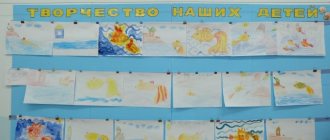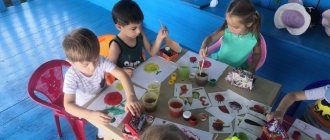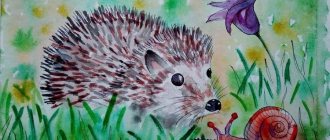The question “How to teach children to draw a person?” It baffles many adults: not everyone can realistically convey proportions and portrait likeness, much less explain the stages of drawing a human figure to a child. We will show simple diagrams and give recommendations on how to draw a person step by step - even an adult child can do it.
shkolabuduschego.ru
Most adults, not engaged in professional artistic activities, stopped in their development at the “cephalopod” stage. But this is not a reason to turn away a child with a pencil who wants to explore this world and learn everything.
By drawing, the child fantasizes, develops his abilities, and trains visual memory. Of course, drawing a person is much more difficult than a tree or a hedgehog, but even the most complex task can be broken down into simple steps so that it does not seem so scary and impossible. Let's learn together!
On the topic: methodological developments, presentations and notes
Summary of a drawing lesson in the senior group, based on the Russian folk tale “The Snow Maiden”.
Program content: Continue to teach children to draw a human figure in motion, observing the proportions of body parts, conveying the beauty of ballerinas through color, movement, smooth lines and emotions. Developed
LESSON SUMMARY ON DRAWING A PERSON (MIDDLE GROUP), TOPIC: “PORTRAIT OF THE SNOW MAID” Technique: Drawing with gouache paints. Program tasks: Learn to draw a human figure, conveying the shape of the part.
Summary of a lesson on art activities (non-traditional drawing with elements of appliqué) in the nursery group “Herringbone” Chernikova Valentina Petrovna. Goals: To introduce children to non.
Summary of a lesson on drawing a person “Snow Maiden in a Fur Coat” (middle group) Purpose: • To arouse children’s interest in a fairy-tale image, the desire to convey it in a drawing; • To teach children how to create.
SUMMARY OF A DRAWING CLASS IN A MIDDLE GROUP ON THE TOPIC: “THE SNOW MAIDE”.
I offer you a summary of a lesson for children of the preparatory group (6-7 years old) on the topic “A little boy.” This material will be useful to teachers of the preparatory group.
Source
How to teach a 5-6 year old child to draw a person: proportions
Teach your child to see the invisible. Before drawing a dressed figure, you need to outline the frame, understand the position of the arms and legs, the direction and rotation of the body relative to the head, etc. Use diagrams; you can always remove extra lines from the drawing with an eraser.
infourok.ru
When a child learns to think in diagrams, he will not have any difficulties when drawing a human figure.
Preschoolers aged 5-6 years can safely explain how the figure of an adult differs from the figure of a child. The module with which we “measure” the figure is the head. A lot depends on how many times the head is “placed” in the diagram of the human figure.
artrecept.com
Show a photo of a child standing next to an adult. Offer to measure (with a ruler, strip of paper, etc.) how many times the child’s head “fits” in his entire figure. Do the same with the adult figure. The child himself will conclude that children have larger heads (relative to the proportions of the whole body).
sovetunion.ru
In adults, the head “fits” 7-8 times (ideally). If you take this into account when drawing a person, the figure will come out proportional and similar.
profymama.com
It is enough to draw a simple diagram several times in order to continue drawing fat and thin people, men, women and children.
Male and female figures are different. These differences can easily be shown in the diagram using geometric shapes. Men have broad shoulders, women have broad hips.
Very soon your child will learn the basics of drawing a person and will be able to portray the whole family!
Lesson summary for the middle group “Drawing a Person”
Yulia Rakhmatullina
Lesson summary for the middle group “Drawing a Person”
Purpose: To train children in depicting a person .
Educational. Teach children to draw a person with watercolors, conveying the characteristic features of appearance.
Developmental. Develop the ability to draw a person in a certain sequence;
Educational. To educate: accuracy, perseverance, interest in the result obtained; educational interest in the defenders of the Fatherland.
Creative. Develop children's creativity, cultivate emotional interest in the result of their work;
Preliminary work. Examination of illustrations of soldiers, educational activity about the defenders of the Fatherland; conversations about the Russian Army, about the branches of the military, about the Motherland, about the Fatherland; reading fiction; listening to musical works dedicated to the army and defenders of the Fatherland.
Materials and equipment: 1/2 landscape sheet of paper, watercolor paints, a simple graphite pencil, a sippy cup (for each child), brushes, napkins (for each child, a sample drawing, a picture of a military man .
Progress of the lesson.
(the guys are sitting at the table on their chairs)
- Guys, what holiday is coming soon? (February 23)
-On this day, you and I will congratulate our dads, grandfathers, brothers and our boys, future Soldiers.
- What can you give? And what wishes can you wish for?
(Children suggest what to give; one option is to draw a postcard with warriors .)
Before you start drawing, you need to do finger exercises.
There are five fingers on my hand
Five grabbers, five holders.
To plan and to saw,
To take and to give.
It's not hard to count them:
One two three four five!
The teacher shows the sequence of drawing a man in military uniform .
Children draw a portrait on a postcard. The teacher pays attention to technical skills, if necessary, attracts children to the flannelgraph - to clarify the location of individual parts
2. Then we draw the body, arms, legs.
3. Then we draw the hands, cap, boots.
(rotation in front of the chest with arms bent at the elbows)
They sat quietly in the clearing,
(sit down, hands to knees)
And they flew again.
4. Draw in the eyes, eyebrows, nose, and mouth with a simple pencil.
—Which postcard did you like the most?
Tell me again what holiday is coming soon? Dads and grandfathers will be happy with such gifts.
All the work is good, we tried our best!
Summary of an open integrated lesson (drawing, the world around us) in the middle group: “Spring Forest” Purpose: To form in children a desire to get acquainted with, emotionally perceive works of fine art, and notice expressiveness.
Summary of a lesson on fine arts activities in the middle group “Decorative drawing” “Deer - branchy antlers” Decorative drawing Program content: introduce the gingerbread industry of Russia. Learn to decorate a figurine. Lesson summary for visual arts in the middle group. Drawing with gouache paints “A rocket flies into space” Educational objectives: Continue to teach children to convey in the image not only the basic properties of objects (shape, size, color, but also characteristic ones.
Summary of a lesson on unconventional drawing in the middle group “Leaves”. Technique: drawing on a wet sheet Prepared by PDO: Sigareva S.V. Objectives: • Teach children to draw in an unconventional way “on a wet sheet” • Continue to develop technical skills.
Summary of a lesson on cognitive development with children 4–5 years old in the middle group “Human Organs” GOAL: to educate preschool children about the internal structure of a person. Objectives: teach children to distinguish and name parts of the body and internal ones. Summary of a drawing lesson in the middle group. Drawing the Chuvash ornament “Jug” The lesson was prepared by the teacher Okruzhnaya Nadezhda Pavlovna MBDOU “Kindergarten No. 19” Kanash, Chuvash Republic Goal: To introduce children to.
Notes for the lesson “Drawing a hedgehog” in the middle group Notes for the lesson “Drawing a hedgehog” (middle group) Objectives: to consolidate the names of wild animals and their habitats; learn to compare, transfer.
I. General provisions
Before drawing the human body, you first need to sketch out the main volumes. Use circles and lines to outline gestures and body position. Never start detailing details from the head and then gradually work your way down. It is necessary to work with the entire figure, moving from rough shape to small details. This will help you see your body proportions clearly and prevent mistakes before you spend too much time on details and end up unable to change anything else.
For clarity, the three stages of drawing a body are shown below:
How to draw a person in motion
Middle school students know a lot about the rules for placing an object in space, taking into account perspective. For students in grades 5–7, it is advisable to start a drawing lesson with an analysis of the structure of the human figure. This is necessary in order to correctly convey the proportions in the drawing, to professionally depict parts of the body, otherwise the real person in the picture will resemble a mannequin. Despite the fact that the anatomy of the human body is studied later, at this age children already have an understanding of the skeleton, muscles and joints. View changes (opens in a new tab)
The first step in building a sketch step by step is determining the proportions. In adults, the length of the body from the top of the head to the hips is usually equal to the length of the legs. The height of the head fits into the distance from the chin to the beginning of the thigh approximately 3 times. This figure is lower in children and adolescents. The length of the legs of a harmoniously built person is equal to the height of the head multiplied by 3.5–4.
You can depict a person depending on the angle or location of the object and the artist. The main positions are in full face, when the sitter is facing the viewer, in profile - when the person depicted is located from the side, half-turned or half-front, in which the face is not completely visible.
Step 1
The pencil drawing begins with a sketch of the head and torso in the foreground.
The spine is the basis of the entire figure; it can be outlined with a curved line. The large joints of the shoulders and pelvis are schematically depicted as circles. The sketch lines are drawn easily, without pressure.
Step 2
At the next stage, the upper and lower limbs are drawn. The elbows are located at waist level, the length of the humerus is equal to the length of the ulna, the knees are in the middle of the leg. The more accurate the sketch, the better the movement will be conveyed.
Step 3
Now you need to build muscle. The most voluminous part of the forearm, thigh and lower leg is located in the upper third; closer to the joint, the limbs gradually narrow. It is easier to depict the body in the form of two ovals.
Step 4
Particular attention is paid to the hands and feet. They are also depicted schematically, imitating the skeleton of the limbs. The foot should be longer than the hand.
Step 5
After drawing all parts of the figure, the extra lines are erased. The silhouette is given the necessary outlines: sharp corners are smoothed out, the sides become sloping, body parts are connected by curved lines.
Step 6
When depicting a face, you also need to maintain proportions. The height of the forehead is equal to the distance from the eyebrow line to the tip of the nose and from the tip of the nose to the chin. The distance between the eyes is equal to the length of the eye. The ear is depicted just below the eyebrow line. To make a girl smile, the corners of her lips need to be slightly raised. At this stage, you can sketch the hairstyle.
Step 7
The more details there are in the drawing, the more realistic it will be. You need to draw clothes, shoes, accessories and other elements that create a bright image. Strands of hair can be highlighted with separate lines.
Step 8
You can color the drawing using colored pencils or paints.






